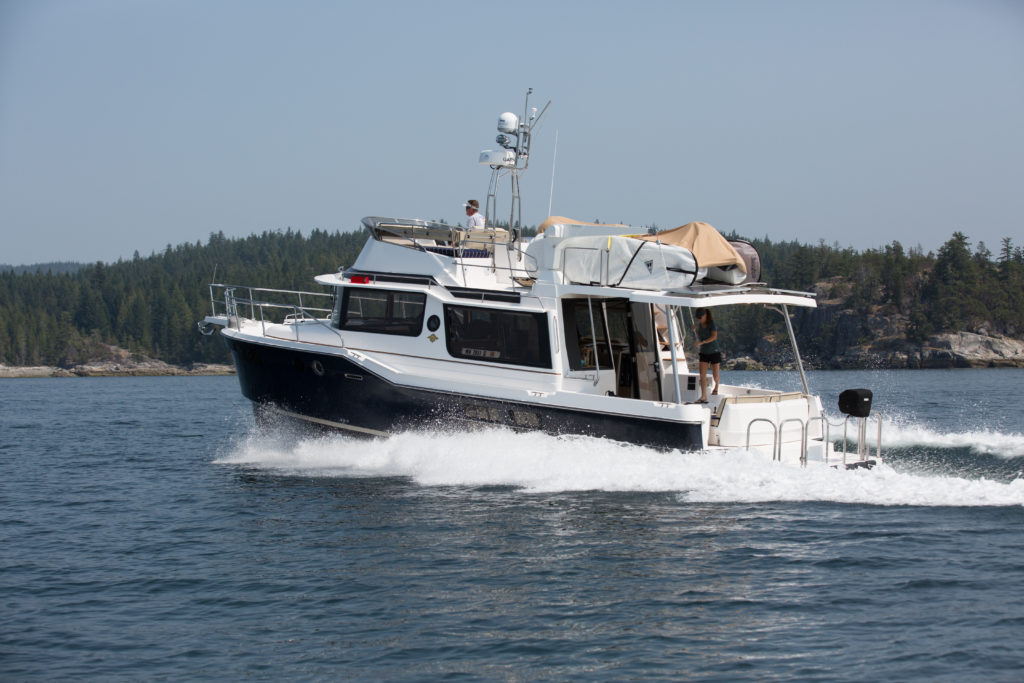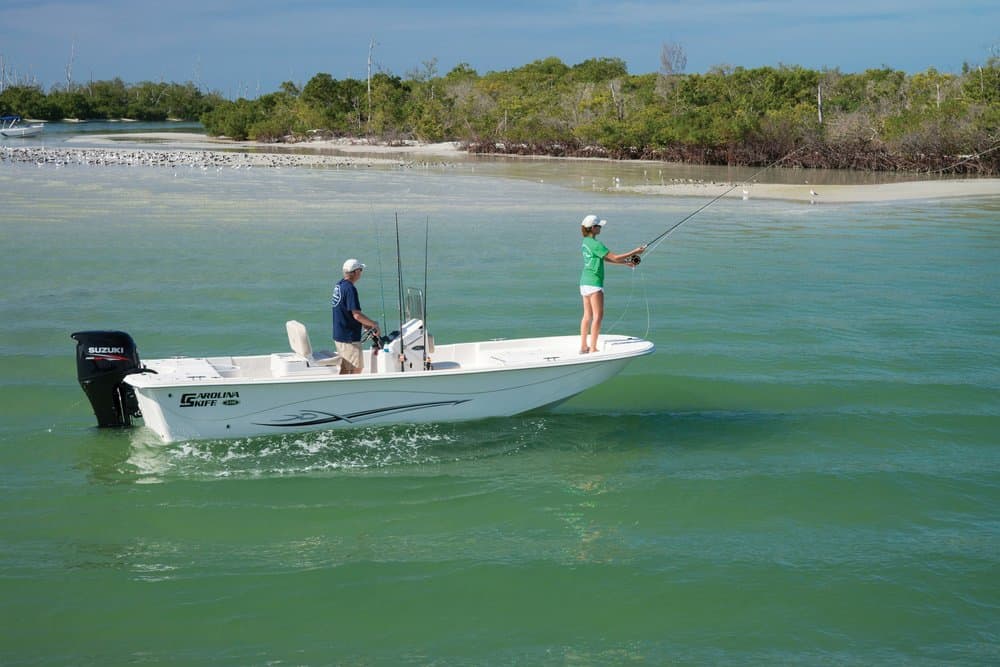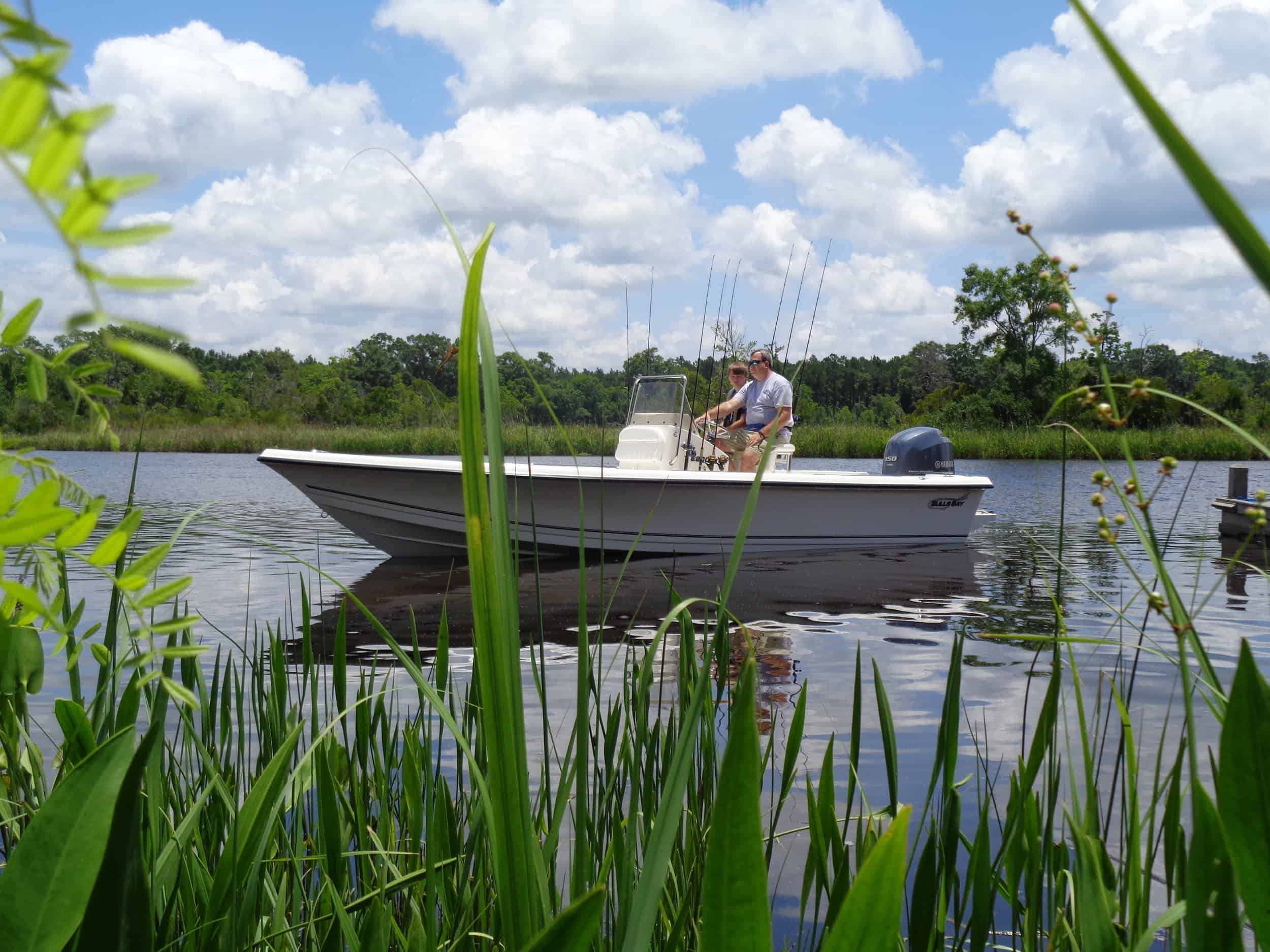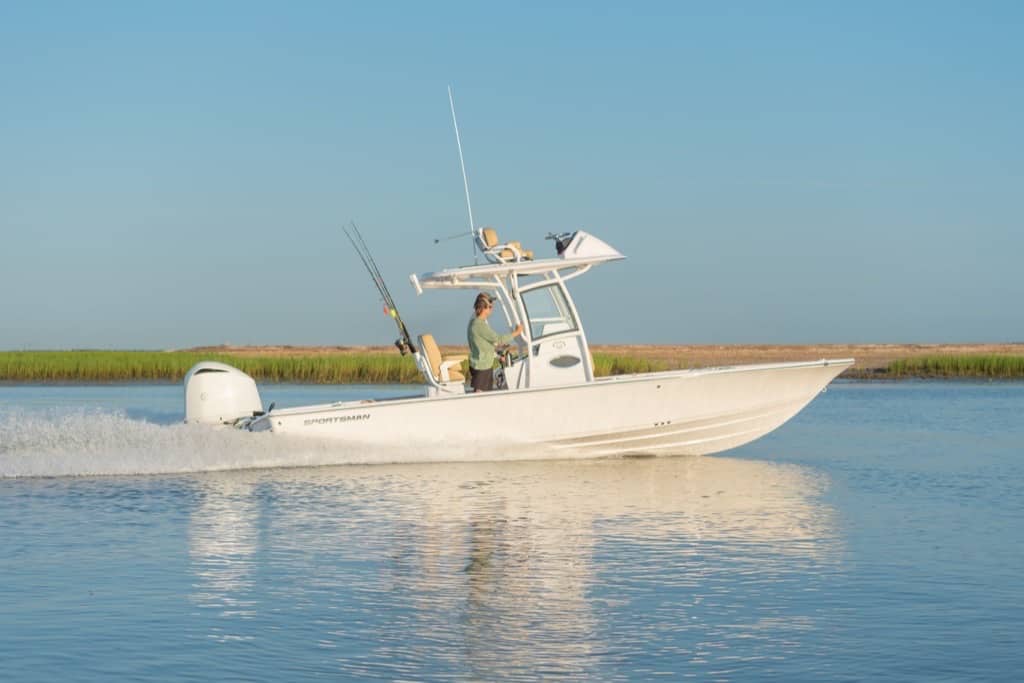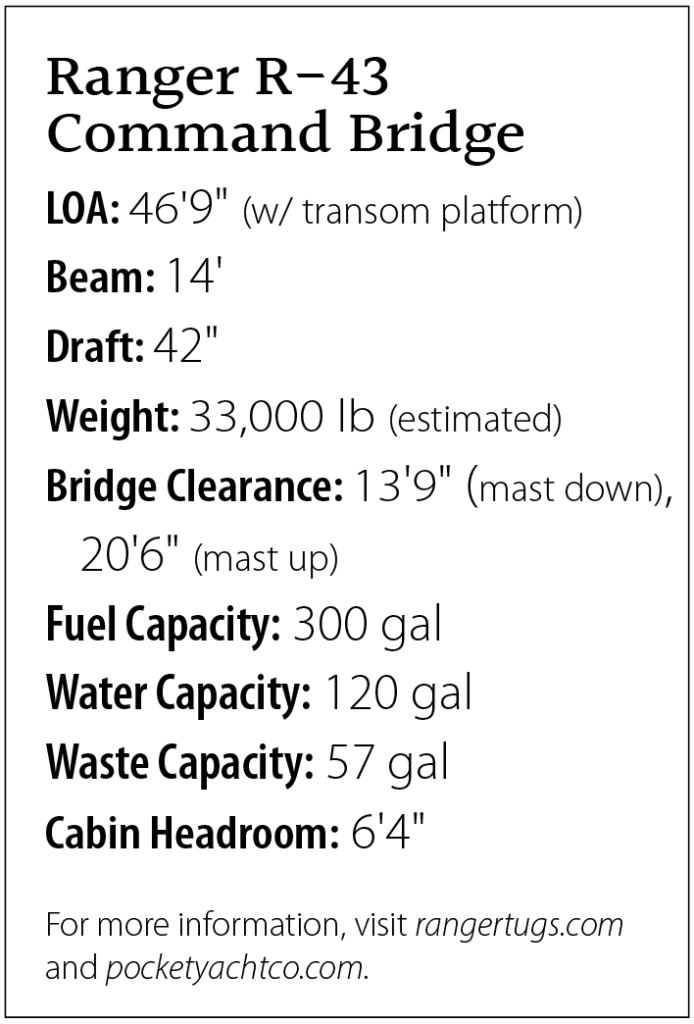
When we took a sea trial of a Ranger R-43 CB in the broad, open Chesapeake off the Northern Neck, her owners were preparing for a roughly 6,500-mile, year-long cruise of America’s Great Loop. By the time you read this review, she and her people will have made it up the Hudson into the Erie Canal, headed for Lake Erie. She’s an ideal boat for a couple to take on this iconic cruise around the eastern United States, with comfortable living accommodations, good seakeeping abilities for a coastal cruiser, a shallow draft (42″) and efficient high and low cruising speeds (18 and 7 knots, respectively).
Coastal cruising is at the heart of the Ranger Tugs brand, and the R-43 CB is the largest model in the line. The company is based in Auburn, Wash., so both employees and customers cruise their boats in Puget Sound, the San Juan Islands and neighboring British Columbia’s Gulf Islands and Queen Charlotte Strait, inside Vancouver Island. Such boats are also naturals for cruising our Chesapeake, with a customer-service-oriented dealer in Pocket Yachts of Grasonville, Md., whose motto is aptly “Live life at sea level.”
We got a good, real-world illustration of the R-43 CB’s capabilities in our sea trial, with northeast winds in the mid-teens, 2–3′ seas with short periods and spitting rain. Ranger builds the boat for the rainy Pacific Northwest, with vertical pilothouse windows, triple windshield wipers and Rain-X that sprays from the washer reservoir. Running into those nasty head seas at speeds in the teens, the bow threw up plenty of spray but the vertical windowpanes and Rain-X cleared our view even without the wipers. Meanwhile, the variable deadrise hull and lifting strakes kept the ride soft with plenty of buoyancy, while the boat’s MC2X Quick Gyro Stabilizer (optional, $66,150) kept rolling to a minimum. Throttled back to “trawler speed,” the R-43 jogged ahead confidently, though riding it in such seas would still make for a long day. “This boat will take more sea than her people will want,” noted her experienced owner as he piloted through the slop. She will clearly bring her crew home safely if caught out in such weather, but most cruisers will elect to stay in port in such conditions unless on a tight schedule.
Concerning tight schedules, the R-43 CB is perfectly capable of meeting them when necessary. Standard power is twin Volvo-Penta IPS-450 forward-facing, dual-propeller pod drives fired by 340-hp electronic D6 diesels. Eighteen knots, with the engines turning happily at 2700 rpm, can cover a lot of water in a 12-hour day, with a range of 220 nautical miles at that speed. At the same time, normal cruising “trawler speed” of 7 knots (1200 rpm) yields a range of about 540 nautical miles.
The master cabin at the bow offers an island queen berth with storage beneath. It is open and bright, with no fewer than 16 windows of varying sizes admitting light around three sides and overhead (including two opening hatches). To starboard are a lounge for comfortable reading, watching television or changing footwear; a hanging locker; and a convenient “office” nook, with a desk and space to the side for a printer. To port lie the enclosed head with innovative circular shower door (“There’s room inside to towel off with the door closed,” remarked the owner), a large flat-screen television, and a long storage cabinet that includes a panel of controls for lighting and climate control.
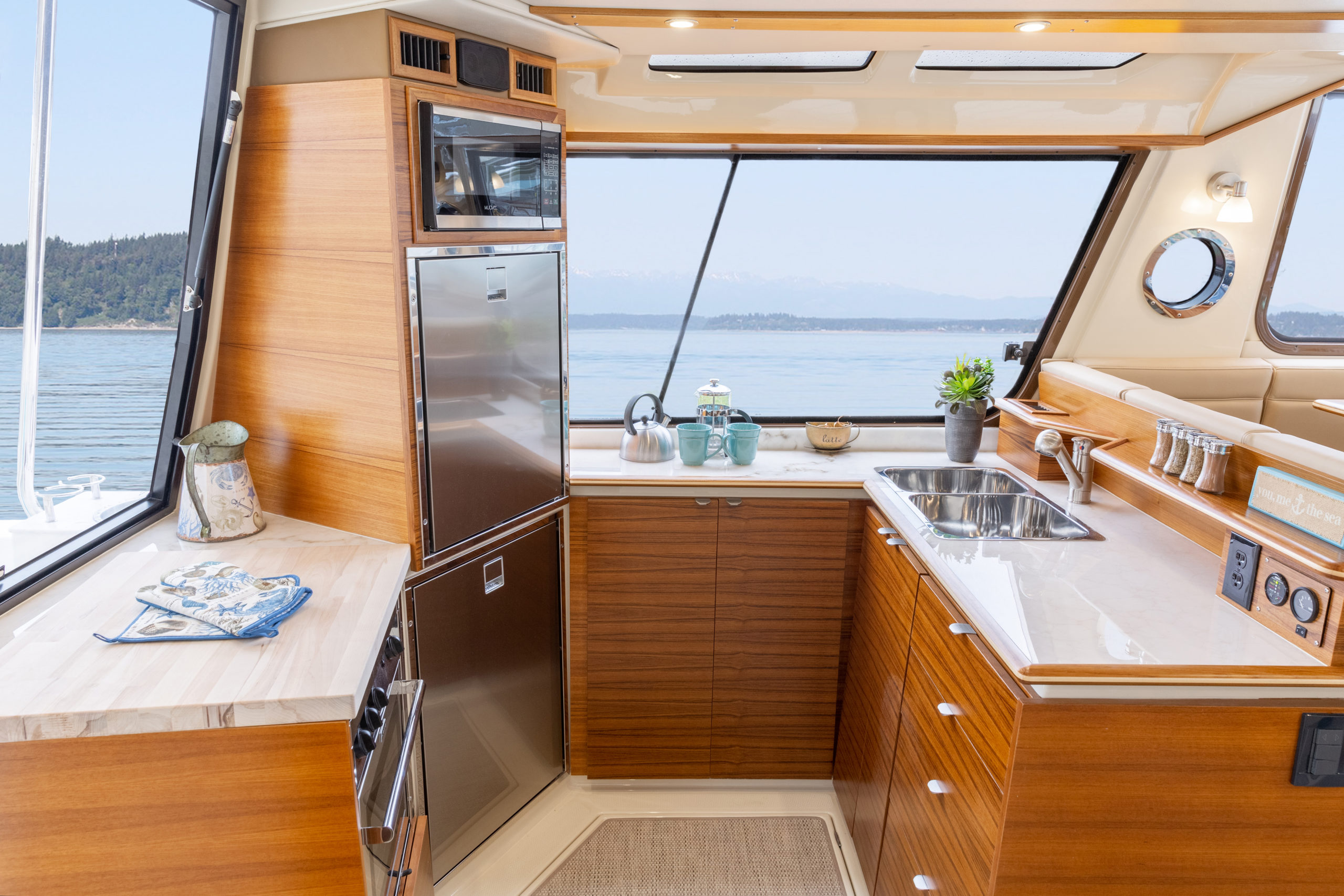
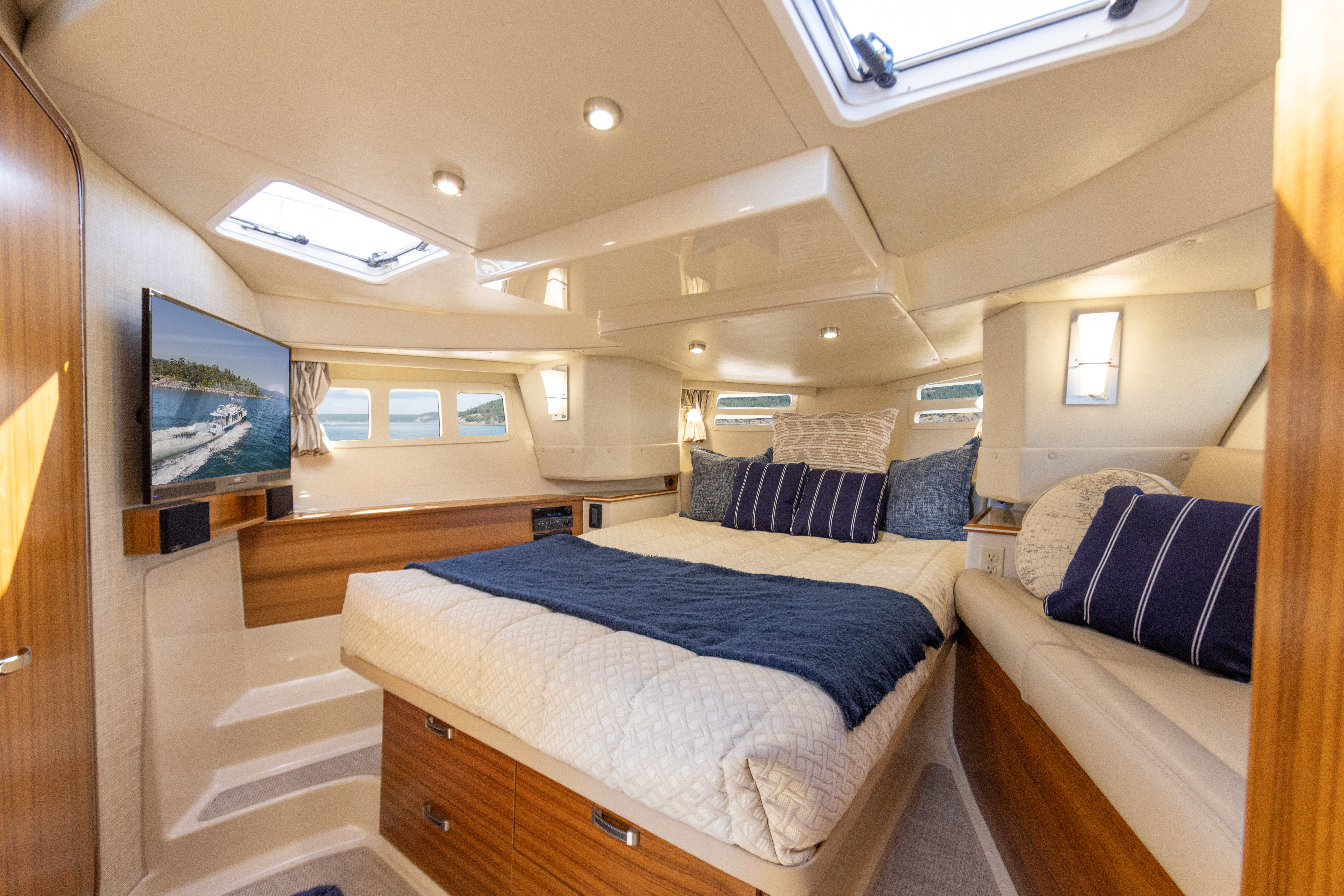
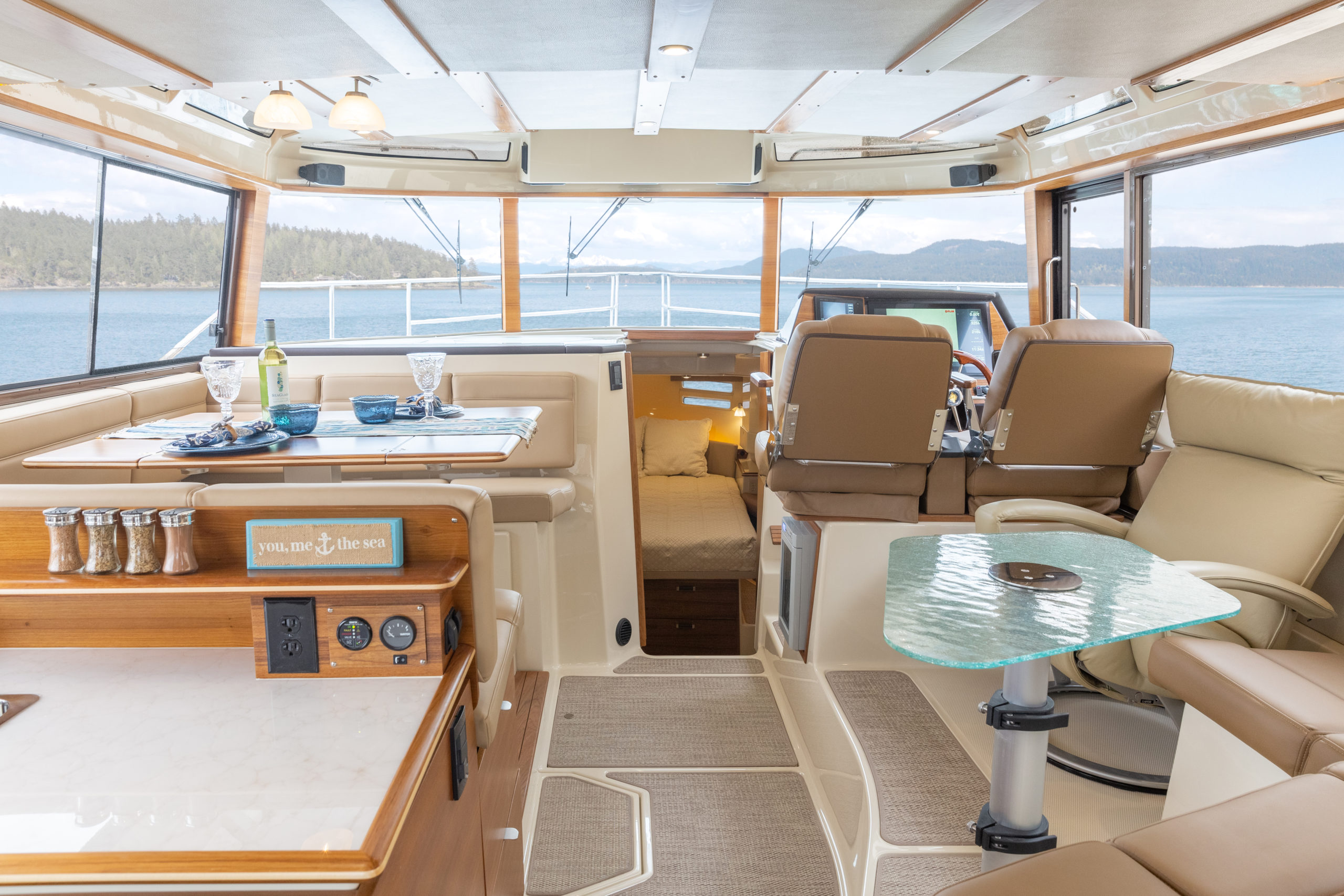
For comfortable living during a cruise, the combined pilothouse/saloon shines. Surrounded by windows, it is bright and airy, with reverse-cycle air conditioning and heat standard. The helm to starboard features twin, individually adjustable seats facing a dash with a 22″ Garmin electronic display, an auxiliary 7″ Garmin display, and a 7″ Volvo display for drivetrain information. The throttle/shift levers and maneuvering joystick mount to the right of the skipper’s seat where the right hand naturally falls on them. Immediately beside them is a sliding door to the side deck, making it easy for the skipper to lean out for a clear view while maneuvering beside a dock with the joystick. The boat has no thrusters, but the twin IPS drives can pivot independently with the joystick, so you can make the boat slide sideways when desired. Volvo’s Dynamic Positioning System (DPS) is optional ($11,025) for holding the vessel on point when docking or waiting for a drawbridge. The helm also includes video cameras for the skipper to monitor the engine room and stern deck. A 7.5 kW Westerbeke genset with 30-gal diesel tank charges batteries and provides AC power when necessary.
To port is a comfortable dinette that seats four and converts to a queen-sized berth when a switch lowers its electrically articulated table. Aft of it is the galley, a U-shaped area beside but completely out of the central walkway. The galley includes two large work surfaces, a butcher block, a double sink, a propane stove with three burners and oven, an over/under refrigerator/freezer and a microwave. An opening window in the aft bulkhead serves as a dumbwaiter to pass food out to the capacious cockpit. On the starboard side of the saloon, a leather recliner sits on a sturdy stainless base immediately behind the helm seats. Aft of it is an L-shaped lounge with another table. Behind this lounge is the entrance to a guest cabin with standing headroom, another queen berth and another enclosed head with shower.
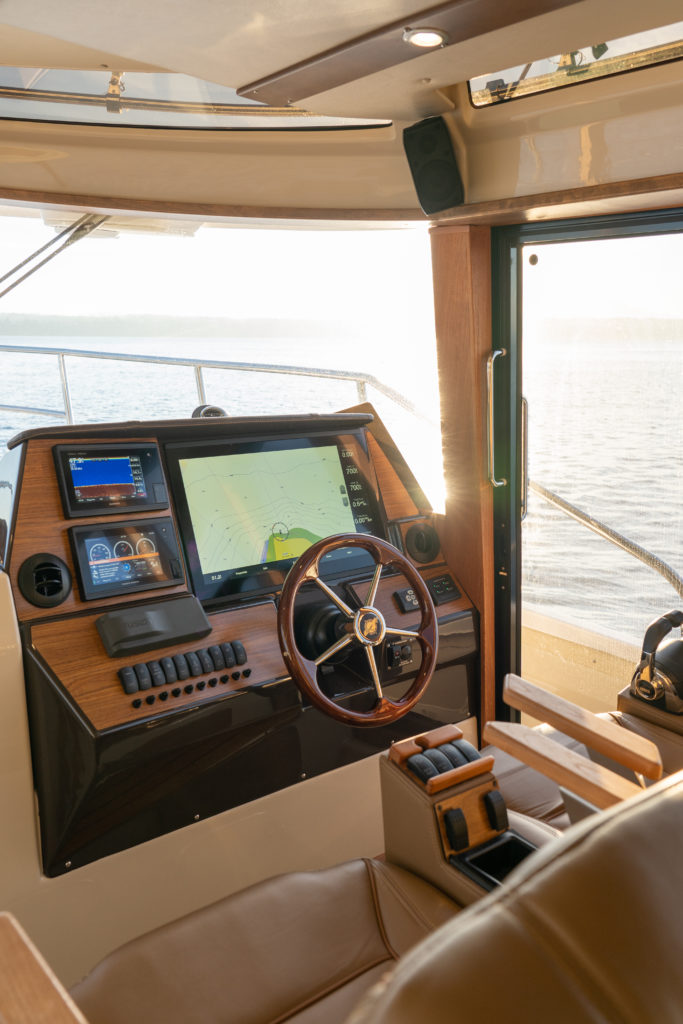
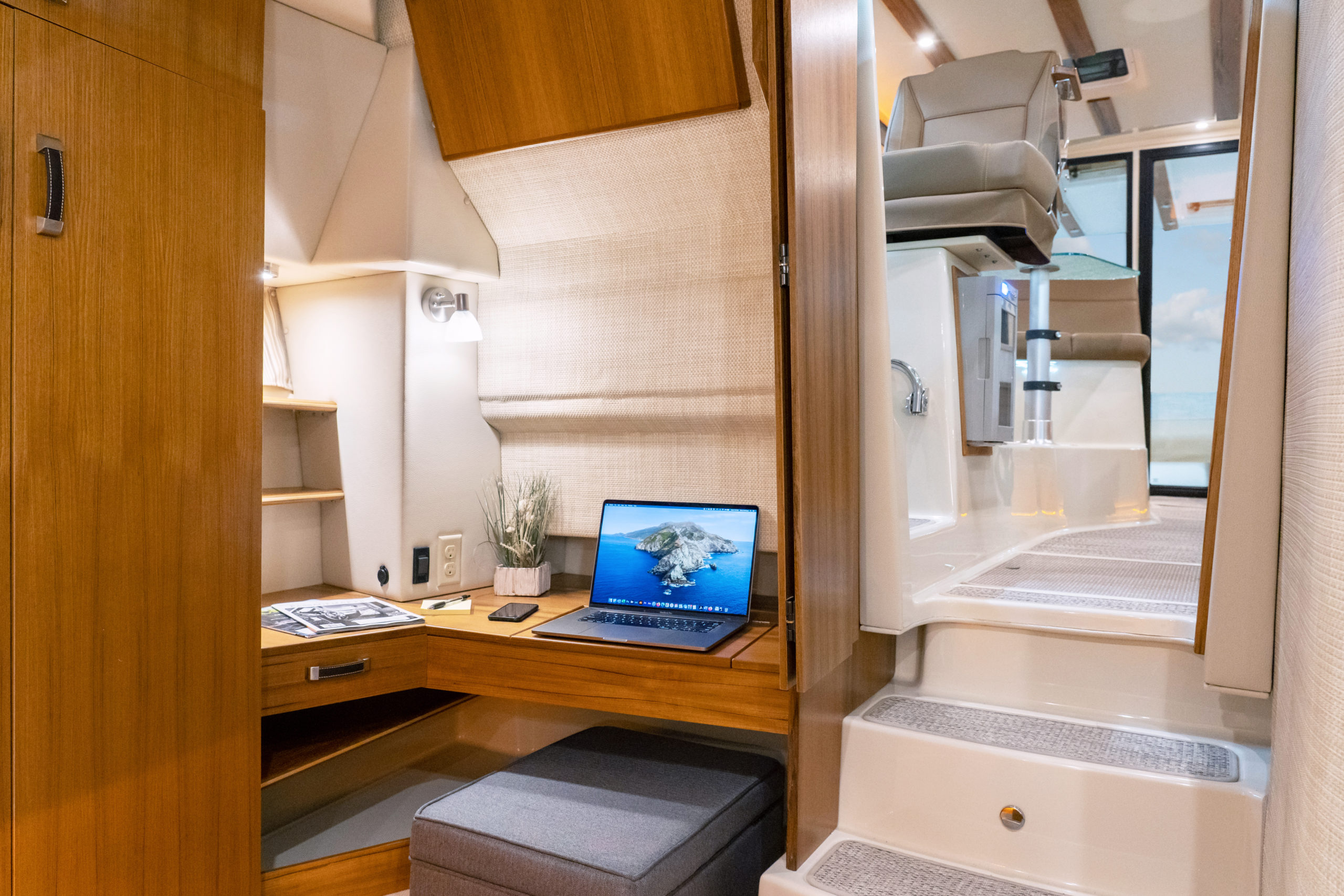
Efficient use of space is one area in which Ranger Tugs takes pride. “If there’s a way to include more functionality per foot, our engineers will find it,” the company likes to say. They are in fact ingenious. For starters, look closely at the portside dinette. At the touch of a nearby switch, the table and the footwell around it rise to reveal a standup-high, below-deck compartment with a washer and dryer, extra refrigerator and freezer, and pantry storage. The design team programmed the dinette’s table to retract as the module rises to prevent damage to the adjacent saloon window. Another switch lowers the table partway to turn the dinette into yet another queen-sized bunk.
The cockpit and full-beam, 36″-deep transom platform form a large outside space, with the former shaded by a hardtop and the latter, if desired, with a fabric sunshade. Gated openings port and starboard allow access from the cockpit to the platform. Three snug-fitting, insulated lazarette hatches on electric rams provide good access to the engines and pod drives for daily checks and maintenance. They also ensure quiet operation. The focal point of the cockpit space is a pair of three-person lounges with tables that can face forward side-by-side, rotate to face each other with the tables coming together, or turn aft side-by-side for sunset watching. Behind them in the base of the transom platform is a wide compartment for multiple propane tanks, readily accessed by a pair of hatches. The cockpit also includes a sink with icemaker to port and steps to the upper Command Bridge to starboard. Tucked under the lower step’s hinged tread is an after helm with joystick for docking.
The stairs lead to the upper deck, with a mount for a 12′ RIB dinghy ($16,535 with 20-hp outboard, small Garmin chartplotter/sounder and safety kit) beside a davit lift for launching. A folding mast mounts radar, VHF, GPS and other antennas. The Command Bridge forward centers around a complete upper helm with 16″ Garmin electronic display, seating for eight around a removable table, and a summer galley with sink, refrigerator, countertop and electric grill. An optional Bimini top ($6,615) shades the space but folds forward to reduce bridge clearance.
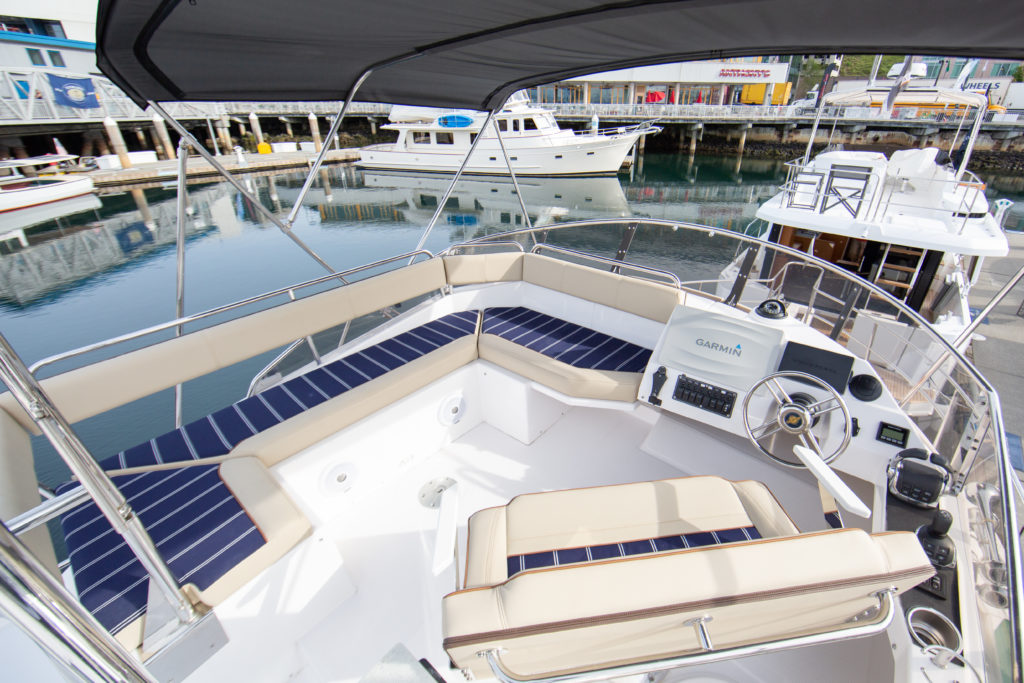
Cockpit steps port and starboard provide careful access to the side decks. The decks are only 6″ wide, but Ranger advertises “safe access to the bow with our exclusive Secure-Path extrusion, which provides positive traction and additional surface area.” The extrusion adds a couple of inches of width and slants upward, helping secure even wide feet, and well-placed handrails all the way to the bow pulpit provide security. The pulpit and foredeck hold mounts and lockers for a pair of anchors with rode and chain. One windlass on the port side, with controls at the bow and the helm, and a 44-lb anchor with 100′ of chain and 225′ of line are standard. There is a mount to starboard for an aftermarket windlass. The foredeck also includes a fold-down cushioned seat for two over the master cabin.
The owners of our test boat, who had previously owned a smaller Ranger, opted for the company’s optional Factory Delivery Experience ($11,025), which includes three days’ instruction in the boat’s systems, handling and maintenance, held at the Auburn plant and on Puget Sound and conducted by an experienced customer service team. They highly recommend it. Ranger strives to offer “the best ownership experience.” The company motto is, “You’re not just buying a boat, you’re joining our family.” That holds true throughout North America, with an online hub, tugnuts.com; Facebook, Instagram and YouTube pages; a company blog, The Ranger Tugs Journal; and regional rendezvous, plus a huge annual factory rendezvous. There’s also a full-time customer care team available to help with problems by phone and online.
Such community and customer service will support our test boat on the Loop until she crosses her wake around this time next year, when she returns to her homeport in Virginia. What’s next for her then? Well, her owners will take some time to settle back into life ashore with their children and grandchildren, but they are already curious about the Chesapeake’s all-water, 1,800-mile Captain John Smith National Historic Trail, following Capt. Smith’s explorations of the Bay and its tidal rivers in the early seventeenth century. Their Ranger R-43 CB is ideal for following the trail all the way to the heads of navigation on our Bay’s rivers. But that’s yet another story for this long-legged boat and her adventurous crew.
The MSRP as tested for the Ranger R-43 CB with twin Volvo IPS-450 is $1,099,937.

